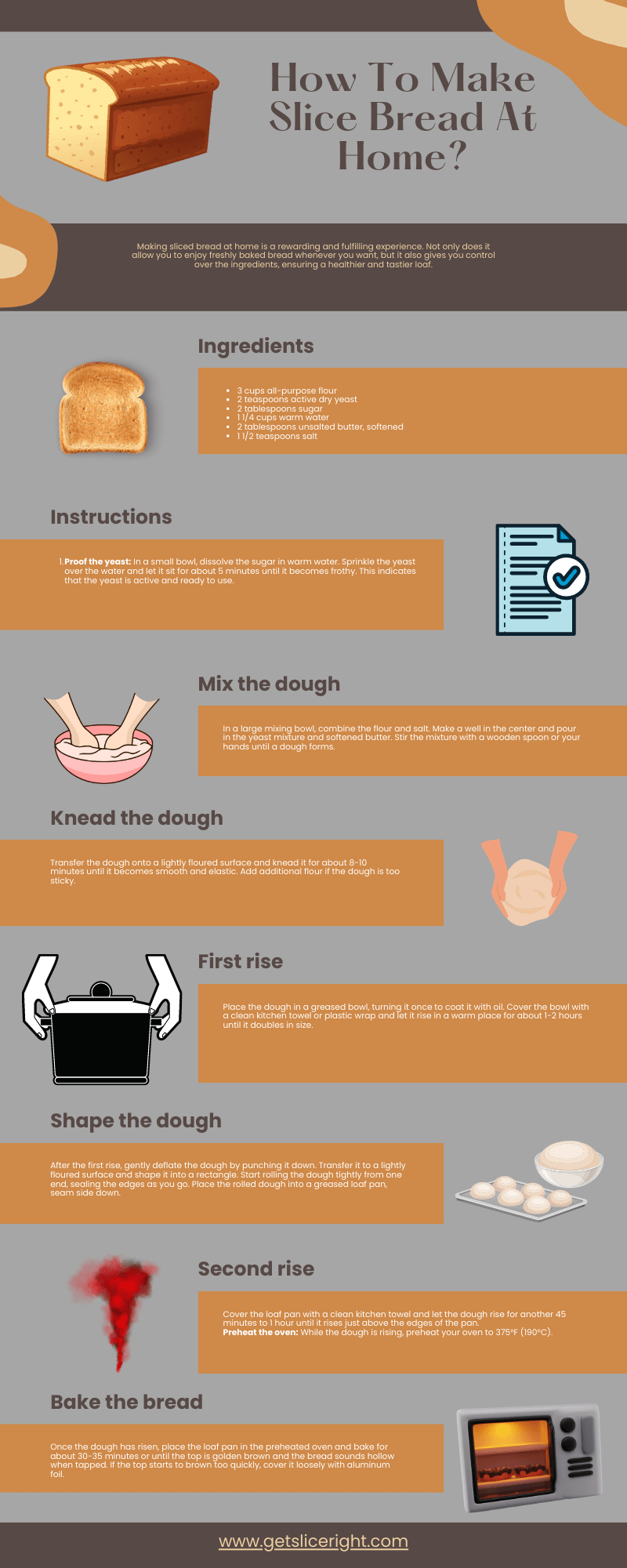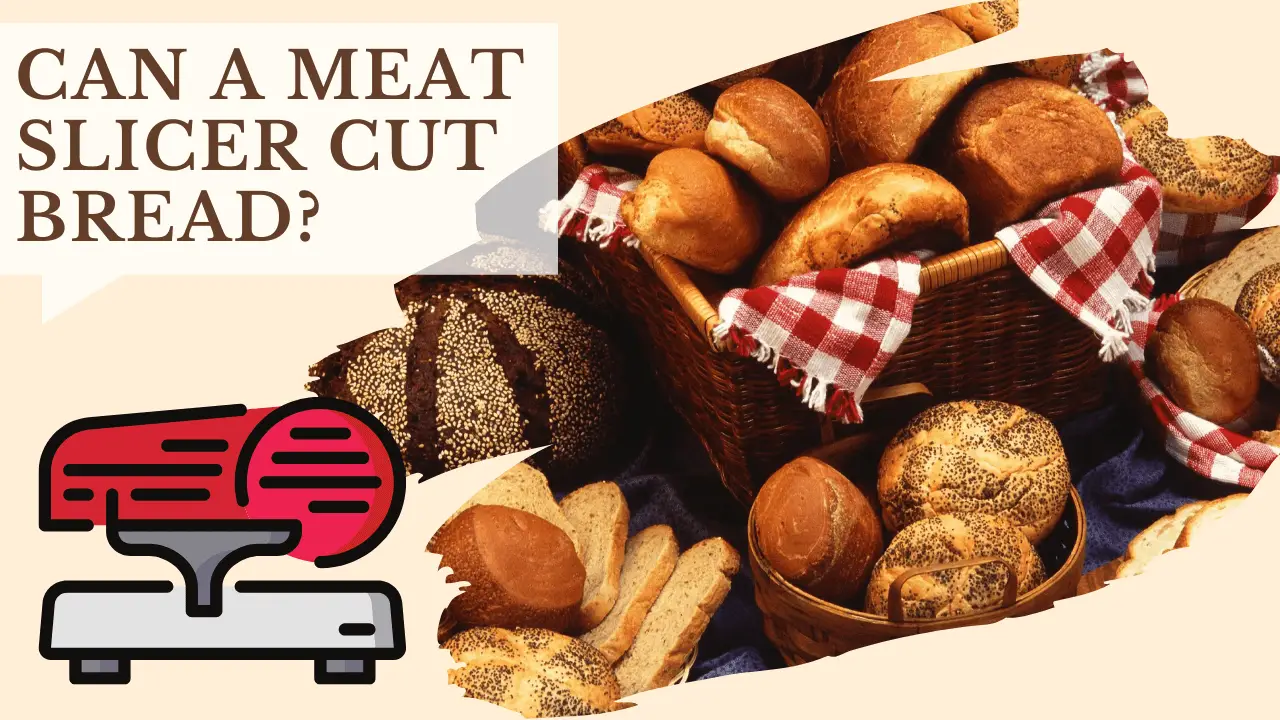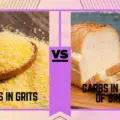Making sliced bread at home is a rewarding task that brings the irresistible aroma of freshly baked bread to your kitchen. It involves combining simple ingredients like flour, water, yeast, and salt to form a dough, kneading it for elasticity, allowing it to rise for the yeast to work its magic, baking it to perfection, and then slicing it for your enjoyment. This process offers the flexibility to control the ingredients and unmatched freshness by store-bought bread.
How To Make Slice Bread At Home?
Ingredients
- All-purpose flour
- Active dry yeast
- Sugar
- Salt
- Butter or vegetable oil
- Warm water
Assemble Bread Ingredients: Gather the ingredients: three cups of all-purpose flour, two tablespoons of active dry yeast, one teaspoon of sugar, one teaspoon of salt, four tablespoons of butter or vegetable oil, and 1 ½ cups lukewarm water.
Dissolve The Yeast And Activate It By Proofing: Take a bowl and add some water to it. Mix the yeast in water and activate it.
Add Remaining Ingredients And Mix: When yeast is fully dissolved in the water, add all remaining ingredients, sugar, all-purpose flour, salt, and oil in the bowl. Mix the ingredients until they form a dough.
Knead The Bread: Now knead the bread until it is soft and smooth. Kneading helps activate the yeast and develop gluten in the dough, which gives it structure. You can knead by hand on a lightly floured surface or put all of your ingredients into a stand mixer and use the dough hook attachment to do this step for you. Knead for 8 minutes or until the dough is soft and supple.
First Rise: Place the dough in a bowl and cover it. Allow the dough to rise for at least an hour. If you’d like your bread to have a more intense flavor, let it rise for up to two hours.
Punch Dough And Shape It: Once you have your dough, punch it down to release the air bubbles. Then knead it for a few minutes until it is smooth and elastic. Finally, shape the dough into a log or rectangle that will fit into your baking pan.
Second Rise: After finishing the dough’s first rise, punch it down and transfer it to a lightly floured work surface. Divide the dough, shape each half into a ball (if desired), and place on a greased baking sheet. Cover with a damp cloth and let rise for about 45 minutes or until doubled in size.
Bake The Bread: Preheat your oven to 350°F (176°C). Place the pan in the center of the oven and bake for 25-30 minutes. Once done, remove from oven, place on a cooling rack, and let cool before slicing.
Slice The Bread: Use a bread knife with a serrated blade to make uniform slices. You can also use a large chef’s knife or an electric knife. Cut in a sawing motion, applying gentle pressure and ensuring you don’t press too hard on the bread. For best results, cut straight down and not at an angle. Move the knife back and forth as you slice so that each piece is more or less evenly cut.
What Should Be The Dimension Of Bread Pan?
A standard bread pan for baking a loaf of homemade sliced bread should be 8.5 x 4.5 x 2.75 inches (21.59 x 11.43 x 6.99 cm). However, the size and shape of the pan can vary depending on what kind of bread you are making—for example, long, thin French loaves will require a longer and thinner than a traditional sandwich loaf. Be sure to adjust your recipe accordingly, depending on the size of your bread pan. Also note that some recipes may even call for specific dimensions or materials—for example, stone bread pans can help create an especially crispy crust.
How To Store Homemade Slice Bread?
The best way to store homemade slice bread is to wrap it tightly in plastic wrap or place it in an airtight container. This will help keep the bread fresh for up to three days.
Tips
Remember To Fully Knead: Kneading the dough is one of the most important steps to making the perfect loaf. When kneading, use your hands and arms to work the dough for at least 10 minutes until it’s fully elastic.
Weather Can Affect Your Ingredients: Weather can affect the performance of certain ingredients when making homemade slice bread. In hot and humid weather, the yeast may become too active and cause your dough to rise too quickly, so adjusting the amounts used in your recipe is important. If you use a recipe with butter or other fats, ensure they are at room temperature to blend properly into the dough. If you are using a recipe with milk, make sure it is not too cold, as this could also affect how your bread turns out. It is best to store all ingredients in a cool, dry place until you are ready to begin baking.
Temperature Affects: Temperature is a major factor in determining how long your bread will take to rise. Generally, the warmer the environment you work in, your bread will rise quicker. If your kitchen is particularly cold, it may help to preheat your oven for a few minutes and set it up near the oven so the dough can benefit from its warmth.
Don’t Overwork The Dough: It may be tempting to knead too much when making homemade bread, but overworking the dough can result in a dense loaf. Work the dough until it’s combined, then let it rest for 10 minutes before shaping and baking.
Troubleshooting
The bread is burnt from the outside: This could be because the oven is too hot. Check that the temperature setting is correct for your loaf. Additionally, reduce the cooking time slightly or cover the bread with foil for the last 10 minutes of baking to avoid burning.
Bread is raw inside: If bread is not baked from the inside, it will not be properly cooked. To ensure your bread is cooked through, use a thermometer when the bread has finished baking to check that the internal temperature has reached 190F (88C). If it hasn’t, return your loaf to the oven for further baking time.
Bread is too dry: If your bread is too dry, add some butter to the outside of the loaf and place it in a warm oven for just a few minutes. This will give it a nice, golden-brown color while helping to soften the crust. You may also try adding water or milk to the dough before baking.
FAQs
Can I use milk instead of water?
Yes, you can use milk instead of water in your bread recipe. This will give the bread a richer flavor and a slightly firmer texture.
Can I use bread flour instead of AP flour?
You can use bread flour instead of all-purpose flour to make sliced bread at home. Bread flour is higher in protein than AP flour and contains more gluten, so that it will produce a denser loaf with a slightly better structure. However, it is also important to remember that bread flour does not rise as much as AP flour, so you must adjust the amount of yeast according to the recipe for the best results.
How many slices should be in homemade bread?
The size of slices you cut from your homemade bread will depend on the loaf size. If you are making a standard-sized loaf, most people will cut 12 to 16 even slices. However, it is ultimately up to you how thin or thick you would like each slice to be. You can also choose how many pieces you want in your loaf by adjusting the size of the loaf before baking.
Is homemade bread cheaper?
Homemade bread is often much cheaper than store-bought varieties. By making your own, you can usually save money by avoiding the cost of pre-sliced loaves from grocery stores, plus the ingredients are often much more affordable – especially if you buy in bulk or use pantry staples like flour and yeast.
How can I tell if my bread is fully baked?
The bread should have a golden brown crust and sound hollow when tapped. You can also insert an instant-read thermometer into the center of the loaf; it should read around 190°F (88°C) when the bread is done.
Conclusion

Making your own slice of bread is an easy and cost-effective way to enjoy fresh, delicious bread at home. With simple ingredients and basic kitchen tools, you can quickly create and bake the perfect loaf of slice bread.

Mario Batali is a renowned author, food enthusiast, and passionate chef who has dedicated his life to exploring the world of culinary arts. With a love for sharing his knowledge and experiences, Mario has become a prominent figure in the food blogging community, inspiring countless readers with his creativity and expertise.
In addition to his culinary prowess, Mario Batali is also a talented writer with a flair for engaging storytelling. He launched his own food blog to share his recipes, cooking tips, and personal experiences in the kitchen. Over time, Mario’s blog gained a loyal following of food enthusiasts who appreciate his unique approach to cooking and his dedication to using only the finest ingredients.
Mario Batali’s passion for food and his commitment to sharing his knowledge with others have made him a true inspiration in the world of culinary arts. Through his blog, cookbooks, and public appearances, Mario continues to spread his love of food and the joy of cooking with his ever-growing fanbase.







